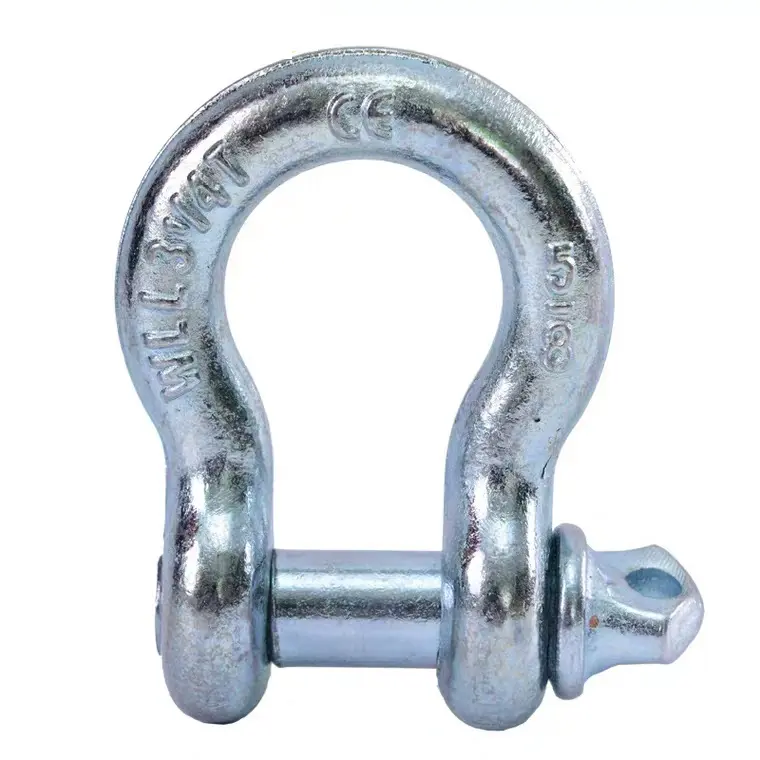News
Oca . 23, 2024 11:47 Back to list
Bolt-Type Shackles
Description:
As the name suggests, a bolt-type shackle comes with a bolt, nut, and a cotter pin, making it a secure rigging tool. With a bolt and nut securing the shackle pin, they remain closed even when subject to rotation. These shackles come in different sizes and designs, including Dee and Bow shackles.
They are also made from various materials, including stainless steel, carbon steel, and alloy steel. You can find them in construction, shipping, and oil and gas, for securing heavy loads during lifting, towing, and other operations.
bow shackle G209
At Holloway, we offer a wide range of bolt-type shackles. Whatever your rigging needs may be, we've got you covered. Just give us a call!
Bolt Type Shackle Application:
These shackles are used in different rigging, lifting, pulling, and hoisting applications. Bolt-type shackles are particularly useful in applications where the load may cause them to rotate.
- Construction:
Shackles like Dee, bow, and bolt-type chain shackles are used in the construction industry to lift and secure heavy materials, including steel beams, concrete blocks, and pipes.
- Shipping:
Bolt-type anchor shackles, Dee shackles, and Bow shackles are used in the shipping industry to secure cargo on ships, barges, and other vessels during transport.
- Offshore Oil and Gas:
Offshore oil and gas operations also rely on bolt-type chain shackles and bolt-type and bow shackles to secure equipment, such as drilling rigs and production platforms, to the seabed.
- Mining:
These shackles are also used in mining to lift heavy equipment and materials, such as drilling rigs, conveyor systems, and ore carts.
- Agriculture:
The agriculture industry uses bolt-type chain shackles to lift and secure heavy loads like agricultural equipment and hay bales.
- Utilities:
Finally, Dee and bow shackles are used in the utility industry to lift and secure power poles, transformers, and other heavy equipment
Bolt-Type Shackle Material:
Bolt-type chain shackles are made from different materials. You will need to choose the right one based on the intended use. Some common materials used to manufacture these shackles include:
- Carbon steel:
Perhaps the most common material used to make bolt-type anchor shackles. It is strong, durable, and relatively inexpensive. Though suitable for most applications, it can be prone to corrosion.
- Stainless Steel:
Stainless steel is the most corrosion-resistant material. You can use stainless steel shackles in harsh environments, such as marine or offshore operations.
- Alloy Steel:
Alloy steel is a high-strength, low-alloy material. As a result, it provides increased toughness and durability. You can see alloy steel bolt-type anchor shackles in shock loading, particularly in the construction and mining industries.
- Galvanized steel:
It is carbon steel coated with a layer of zinc to protect it from corrosion. You can use galvanized steel shackles in the presence of moisture or other corrosive substances.
Bolt-Type Shackle Specifications:
Choosing the right bolt-type shackle helps you plan and lift your load safely and securely. At Holloway, we encourage our customers to consider the following.
- Working Load Limit: The working load limit of the shackle should match the weight of the load you want to lift or secure. Consider this before making your choice.
- Type of Material: Material affects strength, durability, and resistance to corrosion. Choose the material depending on your application and work conditions.
- Size and Type: These shackles come in different sizes and types - like Dee and Bow shackles. Choose the one that best suits your application.
- Pin Diameter: The pin diameter can vary depending on the size and load capacity of the shackle. As it affects the overall strength and load capacity, you should choose a pin diameter that best fits your needs.
- Bow Diameter: It is the distance between the two arms of the shackle. Bow diameter also varies depending on the shackle's size and load capacity. We offer bow shackles with different diameters.
- Pin Type: Pin type is the closure mechanism of a shackle. Most bolt-type chain shackles have a bolt and nut closure mechanism. But some may have a screw pin or a round pin. You can choose the one most suitable for your application.
- Bow Type: The shackles can come in different shapes depending on their intended use. The two most common types of bow shapes are the "U" and the "O" shape.
- Inside Width: It is the distance between the two legs or arms of the shackle body. The inside width determines the compatibility with the lifting or securing equipment.
- Safety Information: Before using a bolt-type anchor shackle, go through the safety information. It's always best to follow the manufacturer's guidelines.
Safety Warning/Notice:
At HHI, all products are sold with the express understanding that the purchasers and end-users know the safe use and application of the products. Please note, use of bolt-type shackles by unqualified persons can cause fatal accidents and injuries. The user is responsible for proper application as per the required standards and regulations. Make sure you understand the manufacturer’s recommendations and the safety information before using the products.

